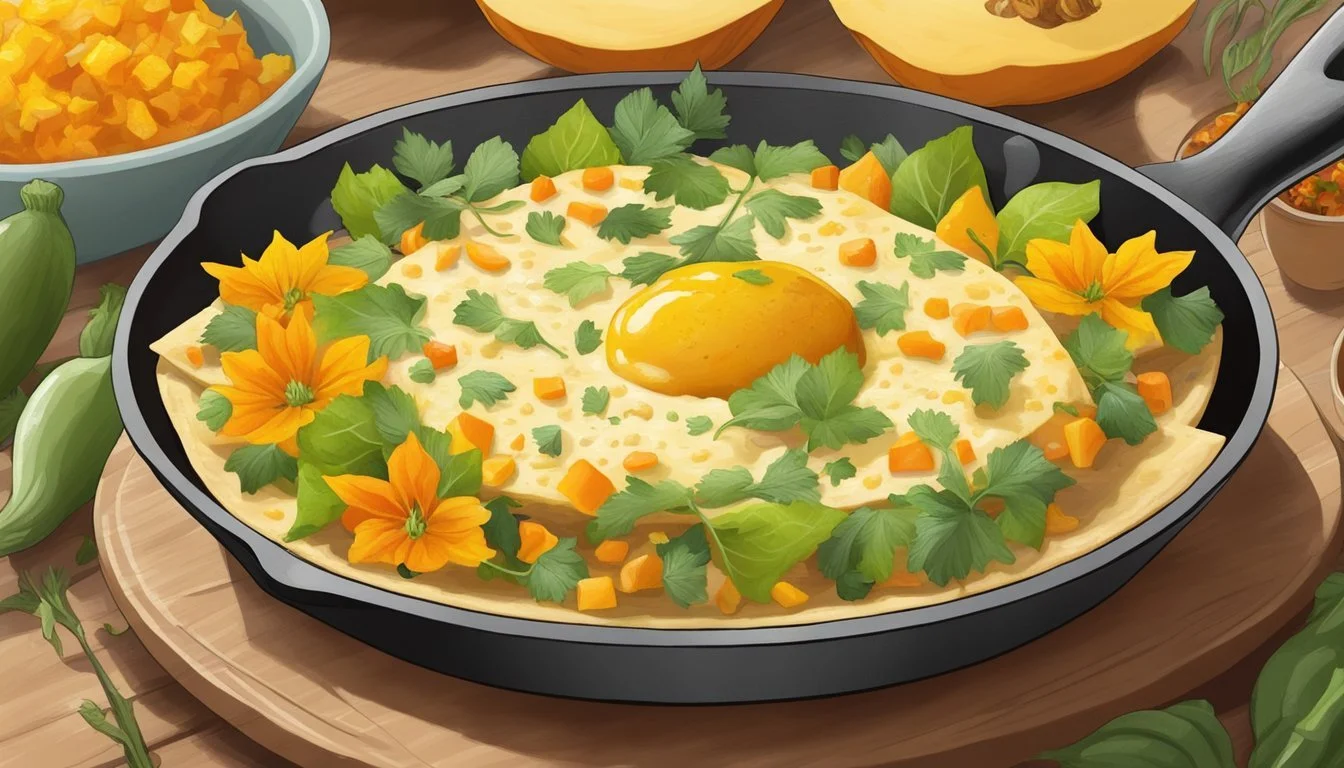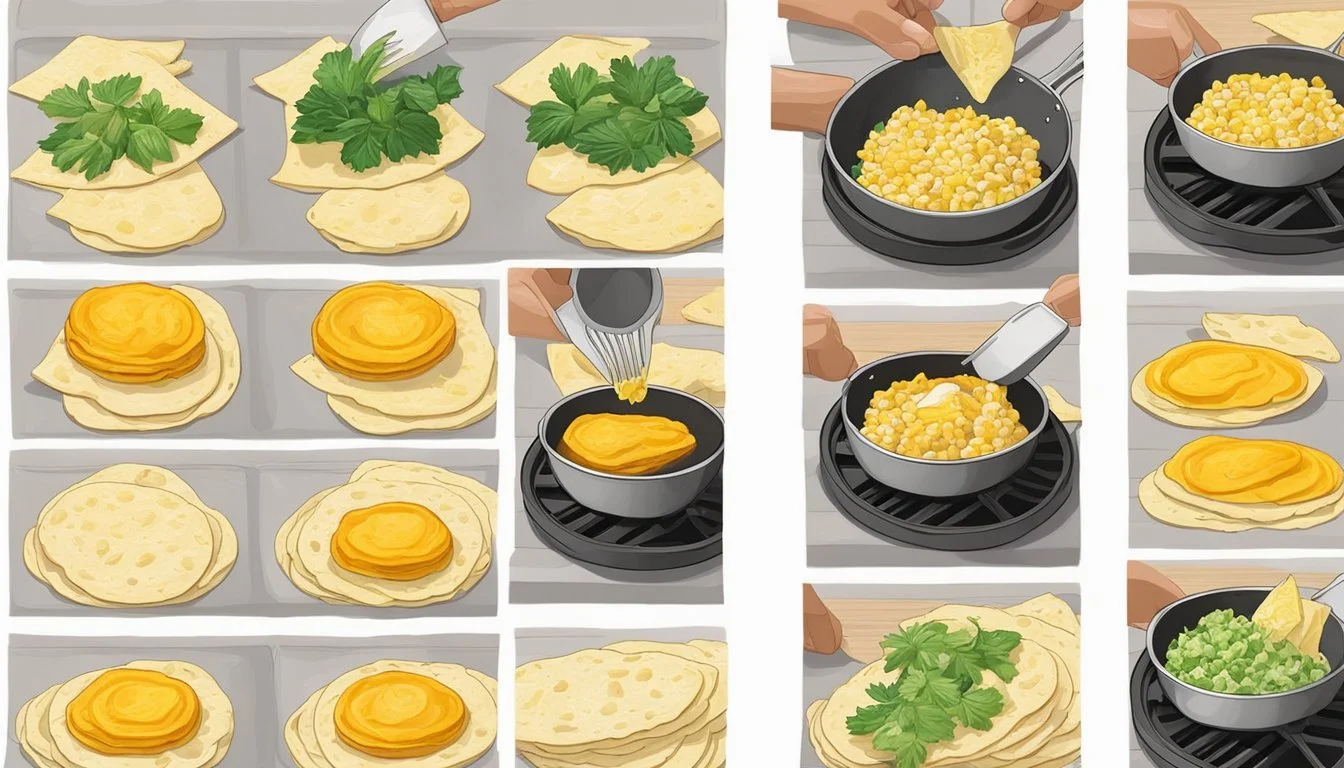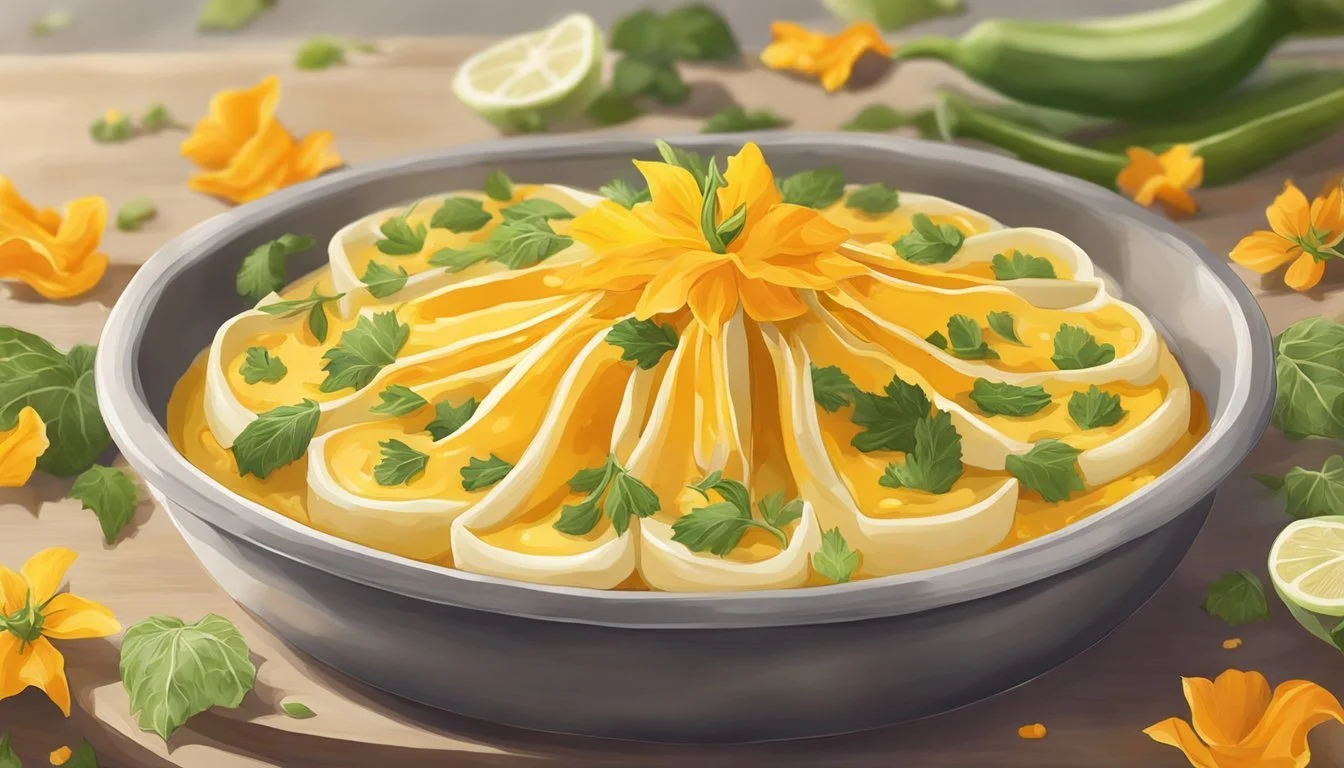Squash Blossom Quesadillas
A Culinary Guide to a Unique Starte
Squash blossom quesadillas blend the delicate flavor of squash blossoms with the rich, melted cheese to create a unique and delicious appetizer. Originating from Mexican cuisine, this dish capitalizes on the brief seasonal appearance of squash blossoms, the edible flowers of the zucchini plant. These blossoms are known for their soft texture and slightly sweet, vegetal taste which pairs marvellously with the creamy texture of melted cheese.
To prepare the quesadillas, fresh squash blossoms are cleaned and may be briefly sautéed with aromatics such as onions and garlic to enhance their flavor. They are then placed on a tortilla, topped with cheese—commonly Oaxaca cheese for its excellent melting properties—and another tortilla is placed on top. The quesadilla is cooked until the tortillas are crisp and the cheese has melted to a gooey perfection, enveloping the squash blossoms in a comforting embrace.
This dish serves as a testament to the creativity of Mexican cuisine, turning a simple flower into a gourmet experience. The quesadillas are often enjoyed as a starter but can also be a light meal on their own, especially when served with a side of guacamole or salsa. Whether for a casual family dinner or a festive gathering, squash blossom quesadillas offer a taste of traditional Mexican flavors with an elegant twist.
The Charm of Squash Blossoms
Squash blossoms, the edible flowers of the squash plant, bring a unique floral note and aesthetic appeal to dishes, particularly in appetizers like quesadillas.
Identifying and Selecting Squash Blossoms
When selecting squash blossoms for culinary use, one should seek out flowers that are vibrant in color and free from wilts or blemishes. Typically found in the garden during summer, these blossoms are available in either male or female variants, with the male blossoms sporting a stamen and females containing a pistil. For cooking purposes, it is important to remove the stamen or pistil from the center to avoid bitterness.
Freshness: Pick blossoms that are freshly opened, with a bright yellow-orange hue.
Size: Large blossoms are typically easier to stuff and handle.
Preparation: Ensure blossoms are clean and gently pat them dry. Remove stems and internal parts such as stamen or pistil before use.
Nutritional Value of Squash Blossoms
Squash blossoms are not only aesthetically pleasing but also offer nutritional benefits. They are low in calories and provide a source of vitamin C and vitamin A, both known for their roles in immune function and vision health, respectively.
Vitamin C: Important for the growth and repair of all body tissues.
Vitamin A: Plays a critical role in maintaining healthy vision and skin.
By incorporating squash blossoms into dishes, one not only adds a delicate texture and appealing look but also incorporates these vitamins into their meal. They represent a harmonious blend of culinary artistry and nutritional goodness, perfect for elevating the traditional quesadilla to something special.
Squash Blossom Preparation
Before incorporating squash blossoms into your quesadillas, they require gentle cleaning and the removal of certain parts. This process ensures a pleasant texture and taste in your final dish.
Cleaning and Preparing Blossoms
One starts by carefully rinsing the squash blossoms under a gentle stream of cool water. It's imperative to remove any dirt or potential insects that may be hiding within the petals. After rinsing, one should lay the blossoms on a clean paper towel and lightly pat them dry. Handling the flowers delicately is crucial as they are quite fragile.
Removing Stamen and Pistil for Cooking
For culinary purposes, the stamen and pistil—the parts containing pollen—should be removed from the blossoms to avoid any bitterness. The removal is done by gently opening the blossom and pinching out the stamen and pistil. One should ensure to complete this step before adding the blossoms to the quesadillas, as this will enhance the dish's flavor profile.
Cheese Varieties for Quesadillas
The choice of cheese is essential for creating the perfect squash blossom quesadilla, with an emphasis on varieties that offer excellent meltability and complement the delicate flavor of the blossoms.
Exploring Oaxaca Cheese
Oaxaca cheese is a traditional Mexican cheese that is renowned for its stringy texture and mild, buttery flavor. Ideal for quesadillas, this cheese melts smoothly and its delicate savoriness enhances the taste of the squash blossoms without overpowering them. It is a semi-soft cheese, comparable to unaged Monterey Jack, but with a distinct personality. Oaxaca cheese is rich in fat and protein, making it a satisfying choice that also contributes calcium to the dish.
Substitutes: Mozzarella and Monterey Jack
For those unable to find Oaxaca cheese, two accessible substitutes are Mozzarella and Monterey Jack.
Mozzarella: Recognized for its mild flavor and excellent melting qualities, mozzarella is a universal favorite that incorporates well into quesadillas. While slightly different in taste, it offers a similar texture to Oaxaca cheese when melted.
Fat content: Comparable to Oaxaca cheese.
Texture: Stretchy and melts easily.
Flavor: Mild, allowing squash blossoms to shine.
Monterey Jack: Another great alternative, Monterey Jack has a flavor profile that is a bit more assertive than mozzarella but remains gentle enough to pair with the squash blossoms.
Fat content: Slightly higher, contributing to a creamy melt.
Texture: Creamy and melts uniformly.
Flavor: Slightly bold but not overwhelming.
Some cooks may also blend cheeses, combining Oaxaca with either mozzarella or Monterey Jack to adjust the flavor and texture profile of the quesadillas. Each cheese brings its own attributes to enhance the dish, making the selection a personal preference based on availability and taste.
Making Corn Tortillas
When preparing Squash Blossom Quesadillas, the foundation for this savory treat is a well-constructed corn tortilla. Its texture and flavor are pivotal in complementing the delicate taste of the flowers and the melting cheese.
The Basics of Corn Masa
Traditional corn tortillas begin with corn masa, a dough made from nixtamalized corn. This process involves soaking and cooking corn in an alkaline solution, usually limewater, and then hulled. This treatment enhances the corn's nutritional value, flavor, and allows it to be ground into masa. For every cup of masa harina (corn dough flour), mix in about half to three-quarters of a cup of warm water. Kneading this mixture will then produce the pliable dough needed for tortillas.
Hand-Pressing vs. Store-Bought Tortillas
Hand-pressed tortillas offer a homemade authenticity that can't be matched by store-bought varieties. To make them, a tortilla press comes in handy. Simply roll a small ball of dough, place it in the center of the press between two pieces of plastic, and apply pressure to flatten.
For those short on time or without a press, store-bought corn tortillas can be a convenient alternative. When using pre-made tortillas, they should be heated up on a hot surface, such as a comal, to bring back a bit of the fresh-made quality, before assembling the quesadillas.
Remember, while flour tortillas are also an option for quesadillas, they do not offer the same authentic flavor or texture profile that corn tortillas do for Squash Blossom Quesadillas.
Quesadilla Assembly
When preparing squash blossom quesadillas, the process of layering the ingredients and employing the correct folding technique are essential to create the perfect appetizer. These steps ensure a well-distributed filling and a crisp exterior, making every bite a delightful blend of flavors and textures.
Layering Ingredients
Prepare the Pan: Start by heating a teaspoon of olive oil or butter in a large sauté pan over medium heat.
Sauté the Onion: Once the pan is heated, add the finely chopped onion and sauté for about 3 to 5 minutes until they become translucent and tender.
Add Squash Blossoms: Incorporate the squash blossoms to the pan, and sauté them with the onion for 1 to 2 minutes until they are slightly wilted.
Assemble on Tortilla: Place a corn or flour tortilla in another pan over medium heat. Spoon the squash blossom and onion mixture onto one half of the tortilla.
Add Cheese: Generously sprinkle Oaxaca cheese or another melting cheese over the squash blossoms.
The Folding Technique
Creating the Half-Moon Shape: Once the cheese begins to melt, carefully fold the tortilla in half over the filling, pressing down slightly to secure the ingredients inside and to create a half-moon shape.
Cooking To Perfection: Continue to cook the quesadilla, flipping once, until both sides are golden brown and the cheese has thoroughly melted. This process should take about 2 minutes per side, but one should watch carefully to avoid burning.
The use of olive oil or butter in the pan not only prevents the quesadilla from sticking but also contributes to the final golden-brown crust. Layering the ingredients ensures an even distribution within the quesadilla, while the folding technique is vital for keeping the filling enclosed and allowing the cheese to become the edible 'glue' that holds the quesadilla together. Cooking the assembled quesadilla on both sides solidifies the shape and melds the flavors for an appetizing experience.
Cooking Techniques
Mastering the right cooking techniques can elevate the simple quesadilla into an exceptional appetizer. The tenderness of squash blossoms combined with the right amount of heat and cooking surface are crucial for a perfect outcome.
The Art of Frying Quesadillas
When frying squash blossom quesadillas, it's vital to select suitable oil with a high smoke point. Vegetable oil, olive oil, or lard can be used, depending on flavor preference and dietary restrictions. One should heat the oil in a large sauté pan over medium-high heat to ensure the quesadilla cooks evenly and acquires a crispy exterior.
Heat: Medium-high
Oil Choices:
Vegetable oil (neutral taste, high smoke point)
Olive oil (for a hint of flavor, moderate smoke point)
Lard (traditional richness, high smoke point)
Using a Comal or Griddle
For those who prefer a less oily approach, using a comal or griddle to cook quesadillas provides an even cook with less fat. The key is to maintain a consistent medium heat to ensure the cheese melts adequately without burning the tortilla. Preheating the surface is a must to avoid sticking and to achieve that desirable slight char.
Tool: Comal or griddle
Heat: Medium, preheated
Cooking Time: Varies until cheese is melted and tortillas are golden
Serving Recommendations
When serving Squash Blossom Quesadillas as an appetizer, they are complemented well by a range of salsas and side dishes that can enhance their cheesy and floral notes, creating a more complete gastronomic experience.
Pairing with Salsas
Salsa Verde: A tangy and herby salsa verde, made with tomatillos and fresh cilantro, provides a bright counterpart to the quesadillas. Its slight acidity balances the richness of the cheese.
Tomato Salsa: A classic tomato salsa brings a combination of sweetness and heat that pairs nicely with the subtle flavor of the squash blossoms.
Spicy Fruit Salsa: For a surprising twist, a spicy fruit salsa, such as mango or pineapple, adds a tropical sweetness and a kick that elevates the dish.
Side Dish Possibilities
Salad: A light salad with a vinaigrette dressing makes an ideal side dish, offering a crisp and refreshing contrast to the quesadillas.
Grilled Vegetables: (What wine goes well with grilled vegetables?) Seasonal grilled vegetables, brushed with olive oil and seasoned with salt and pepper, can accompany the quesadillas, adding a smoky flavor and additional texture.
Beans: A side of black or pinto beans, whether refried or whole, not only complements the quesadillas but also adds protein to the meal.
Culinary Context
Squash blossom quesadillas skillfully blend the delicate flavors of seasonal produce with the quintessence of Mexican cheese-filled tortillas. This dish is a testament to the adaptive nature of traditional Mexican cuisine where regional ingredients meet classic culinary techniques.
Squash Blossoms in Mexican Cuisine
In Mexican cuisine, squash blossoms, or flores de calabaza, are a cherished ingredient especially during their peak season. They are notable for their vibrant color and subtle, zucchini-like flavor which contribute to the culinary aesthetic and taste of a dish. These edible flowers are often found fresh in markets across Central Mexico and play a significant role in traditional dishes. The flowers' soft texture and fine taste make them a perfect filling for quesadillas, a type of stuffed tortilla that is a staple in Mexican households and eateries. Squash blossom quesadillas, known locally as quesadillas de flor de calabaza, celebrate the delicate balance of simplicity and flavor that is central to Mexican cooking.
Quesadillas de Flor de Calabaza in Oaxacan Cooking
The cuisine of Oaxaca, a state known as the gastronomic heart of Mexico, embraces quesadillas de flor de calabaza as a regional specialty. Here, the art of creating the perfect quesadilla involves pairing the gentle squash blossoms with Oaxaca's famed stringy cheese, quesillo. The combination of local cheese and fresh blossoms folded into corn tortillas and cooked to a golden crisp highlights Oaxacan cooking's dedication to depth of flavor and textural contrast. This traditional Oaxacan appetizer reflects the region’s rich culinary heritage and emphasis on fresh, indigenous ingredients.
Nutritional Information
Squash Blossom Quesadillas offer a unique balance of nutrients, beneficial for those looking for a tasty yet health-conscious appetizer. A single serving typically contains a moderate amount of calories, primarily from carbohydrates and protein, with a smaller contribution from fats.
Calories: A typical Squash Blossom Quesadilla portion can contain approximately 250-300 calories. This may vary based on the size and additional ingredients included.
The key nutritional components are as follows:
Carbohydrates: Mostly present in the form of corn tortillas, they are the primary energy source, averaging about 20-30 grams per serving.
Protein: Cheese and squash blossoms contribute to the protein content, with each serving providing roughly 8-12 grams.
Fats: These are primarily contributed by the cheese and cooking oil. A mixture of saturated, monounsaturated, and polyunsaturated fats are present with the content influenced by the type of cheese and oil used.
Nutrient Estimated Amount Calories 250-300 kcal Carbohydrates 20-30 g Protein 8-12 g Saturated Fat Varies Monounsaturated Fat Varies Polyunsaturated Fat Varies Sodium Varies
Nutritionally, the quesadillas contain a variable amount of sodium, which hinges on the cheese and added seasonings. Individuals with sodium-sensitive diets should consider the type and amount of cheese used.
To summarize, Squash Blossom Quesadillas are a delightful appetizer that, when consumed in moderation, can fit into a balanced diet. They provide an opportunity to enjoy the flavors of traditional Mexican cuisine while being mindful of nutritional content.







